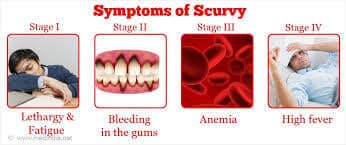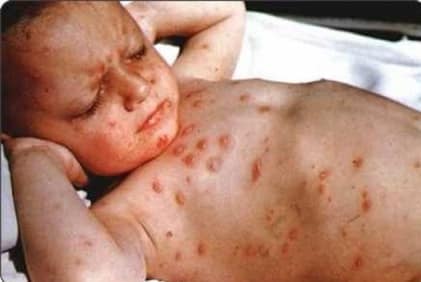Prominent Vitamin Deficiency Diseases
Rickets is a bone problem that affects children. It happens when your child’s bones do not form correctly. Rickets can make your child’s bones hurt, and the bones can bend and break easily.
There are different causes for rickets. Sometimes it may be inherited from a parent. Most times it is related to diet where a child does not get enough Calcium and vitamin D (nutritional rickets). Humans are able to make vitamin D when sunlight shines on the skin. Kids with dark skins or who not spend enough time in the sunlight may also get rickets.
Premature infants or those with kidney or gut diseases which affect the absorption or balance of Calcium in the body are at a higher risk of getting rickets.

Symptoms of scurvy develop after at 3 months of near or total Vitamin C deficiency. The clinical deficiency syndrome is largely due to impaired collagen synthesis and disordered connective tissue.

Early symptoms include:
- Loss of appetite
- Diarrhea
- Fever
- Fatigue
- Painful muscles and joints
- Small visible, pinpoint bleeding around hair follicles
- General feeling of malaise
Late symptoms include:
- Refusing to walk, loose teeth
- Easy and severe bruising of your child’s skin along with bleeding into it
- Gums that are prone to bleeding and appear swollen, purplish in color and spongy
- Bulging of the eyes
- Extremely dry hair that tends to curl and break off close to your baby’s skin
- Dry, scaly and brownish skin
- Slow healing of your baby’s wounds
- Opening of scars that have healed before
- Swelling of the bones arms and legs due to internal bleeding into the joints
- Stopping of your baby’s bone growth before time
- Irritability and anxiety in the case of infants
- Assuming frog leg posture to try and ease the pain
Scurvy has also been described in children with autism spectrum disorder who have very specific and limited diets with strict avoidance of fruits and vegetables. It is often common in children with iron overload due to medical conditions, such as sickle cell disease or thalassemia, or a history of bone marrow transplantation.
Pellagra is caused by a deficiency in the B-complex vaccine, Niacin. It is very rarely seen in kids. It’s typically presents as what is call the three D’s. For our purposes related symptoms are grouped with the three D’s.
- Dementia: apathy, depression, confusion, irritability, or mood changes, headaches, restlessness or anxiety, disorientation or delusions
- Diarrhea: decreased appetite, trouble eating and drinking, nausea and vomiting
- Dermatitis: sores lips, tongues, gums; rash on face, lips, hands, feet

Beriberi is a disease that is called by Vitamin B1 (Thiamine). There are 2 forms: Wet Beriberi that affects the heart. The typical symptoms include:
- Edema: excessive accumulation of fluid in tissue spaces and body cavities.
- Dyspnea (shortness of breath): feeling that you cannot inhale enough air
- Heart failure: inability of the heart to pump a sufficient amount of blood throughout the body, leading to a pooling of blood and shortness of breath.
Dry Beriberi that affects the musculoskeletal and nervous system. It’s symptoms include:
- Weakness
- Peripheral neuropathy: weakness, numbness and pain usually in the hands and feet as a result of damage to the nerves located outside of the brain and spinal cord (peripheral nerves)
- Loss of reflexes
- Ataxia: loss of the ability to coordinate muscular movement
- Weight loss



An anemia is a red blood cell defect that can lead to an undersupply of oxygen. Typically the number of red blood cells (RBCs) is lower than usual. RBCs transport oxygen through the body. When our body does not have enough RBCs, our tissues and organs do not get enough oxygen. Megaloblastic anemia is characterized by RBCs that are larger and fewer in number than normal.
The two most common causes of megaloblastic anemia are deficiencies of vitamin B12 and folate. Symptoms include:
- Fatigue
- Shortness of breath
- Pale skin
- Tender tongue
- Muscle weakness
- Swollen tongue
- Fast heart beat
- Body aches and pain


